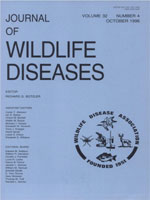Spirochetes were isolated from the tick, Ixodes tanuki, as well as wood mice (Apodemus speciosus) and voles (Clethrionomys rufocanus and Eothenomys smithii), caught in Fukui, Tokushima, and Hokkaido, Japan, from 1991 to 1993. Spirochetes were characterized on the basis of protein profiles, reactivities with monoclonal antibodies (mAbs), Outer surface protein A gene (ospA) and Outer surface protein B gene (ospB) amplification analysis, rRNA gene and flagellin gene restriction fragment length polymorphism (RFLP) analysis, and DNA homology values. Protein profiles of all isolates were homologous and reacted with mAb to OspA, OspB, OspC, flagellin, and heat shock protein 60. The primer reactivity to ospA and ospB were different from those of Borrelia burgdorferi sensu stricto, B. afzelii, B. japonica, and B. garinii. Based on the DNA/DNA homology value and RFLP analysis of rRNA and flagellin gene, these Borrelia sp. isolates are a new group of B. burgdorferi sensu lato. The isolates from ticks and the host rodents were identical in these assays. We propose that these Borrelia sp. are adapted to I. tanuki and are maintained in these field rodents.
How to translate text using browser tools
1 October 1996
CHARACTERIZATION OF BORRELIA SPP. ISOLATED FROM THE TICK, IXODES TANUKI AND SMALL RODENTS IN JAPAN
Toshiyuki Masuzawa,
Hiroyuki Suzuki,
Hiroki Kawabata,
Fubito Ishiguro,
Nobuhiro Takada,
Yasutake Yanagihara

Journal of Wildlife Diseases
Vol. 32 • No. 4
October 1996
Vol. 32 • No. 4
October 1996
Apodemus sp.
Borrelia burgdorferi sensu lato
Clethrionomys sp
Eothenomys sp.
Ixodes tanuki
Lyme disease




